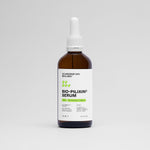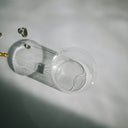Hair loss is a deeply personal and often distressing experience, and when hormones are the suspected culprit, the uncertainty can feel overwhelming. Hormonal imbalances—whether from thyroid disorders, menopause, or conditions like PCOS—are among the most common causes of hair thinning. But is this type of hair loss permanent, or can it be reversed? In this article, we’ll explore the science behind hormonal hair loss, evidence-based treatments, and practical steps to restore your hair’s health.
Table of content
Can Hormonal Hair Loss Be Reversed?
Yes, hormonal hair loss can often be reversed if the underlying hormonal imbalance is identified and treated early. Success depends on the cause (e.g., thyroid dysfunction, menopause, or high DHT), the duration of hair loss, and the treatments used. Medications, lifestyle changes, and targeted therapies like minoxidil or hormone replacement therapy (HRT) can regrow hair in many cases, though results vary by individual.
As your leading source for hair health information over the past 4 years, we never compromise on accuracy. When it comes to your health, you deserve information you can truly rely on - and earning your trust is our top priority.
Here's how Scandinavian Biolabs ensures every piece of content meets the highest standards of accuracy and integrity:
- Credentialed Experts: Our reviewers are actively practicing doctors and medical researchers
- Stringent Reviews: Content undergoes rigorous editing by subject specialists and review by a practicing doctor.
- Evidence-Based: We rely on well-established research from trusted scientific sources like peer-reviewed journals and health authorities.
- Full Transparency: Our editorial standards, writer credentials, reviewer credentials, correction process, and funding are all publicly documented.
- Independent Voice: While we do promote products, we operate in a vacuum to business operations. Our main goal is just an unwavering commitment to providing medically-sound guidance.
You can count on Scandinavian Biolabs to consistently deliver the trustworthy health information you deserve. Read our Editorial Standards.
Understanding Hormonal Hair Loss
Hormones regulate nearly every bodily function, including hair growth cycles. When imbalances occur, they can disrupt the cycle, leading to excessive shedding or thinning. Common hormonal triggers include:
1. Androgens (DHT)
Dihydrotestosterone (DHT), a derivative of testosterone, binds to hair follicles and miniaturizes them, causing androgenetic alopecia. This affects both men and women, though patterns differ.
2. Thyroid Hormones
Hypothyroidism (low thyroid hormones) and hyperthyroidism (excess thyroid hormones) can lead to diffuse hair thinning. Thyroid hormones regulate metabolism, which impacts follicle energy production.
3. Estrogen and Progesterone
Falling estrogen levels during menopause or postpartum can trigger telogen effluvium, a temporary shedding phase. Estrogen prolongs the hair’s growth phase, so its decline shortens the cycle.
4. Cortisol
Chronic stress raises cortisol, which can disrupt the hair cycle and worsen androgen-related hair loss.
5. Insulin and PCOS
Polycystic ovary syndrome (PCOS) drives insulin resistance and elevated androgens, leading to hair thinning in women.
Is Reversal Possible? Factors That Determine Success
While many cases of hormonal hair loss are reversible, outcomes depend on:
1. Timeliness of Intervention
Early treatment increases the likelihood of regrowth. Prolonged hormonal imbalances can cause permanent follicle damage.
2. Root Cause
- Thyroid Disorders: Hair often regrows once thyroid levels stabilize with medication.
- Postpartum/Menopause: Shedding typically resolves within 6–12 months as hormones rebalance.
- Androgenetic Alopecia: Requires ongoing management, as DHT’s effects are progressive.
3. Genetic Predisposition
If you have a family history of pattern baldness, hormonal shifts may accelerate genetic hair loss, making full reversal harder.
Proven Treatments to Reverse Hormonal Hair Loss
Effective strategies address both the hormonal imbalance and hair follicle health.
1. Medications
Anti-Androgens
- Spironolactone: Blocks androgen receptors, commonly used for PCOS-related hair loss.
- Finasteride/Dutasteride: Inhibits DHT production, effective for androgenetic alopecia (primarily in men).
Topical Treatments
- Minoxidil: Stimulates blood flow to follicles, extending the growth phase. Works for both men and women.
- Topical Finasteride: Reduces scalp DHT with fewer systemic side effects than oral versions.
Thyroid Medications
Levothyroxine (for hypothyroidism) or anti-thyroid drugs (for hyperthyroidism) can restore hair growth within 3–6 months.
2. Hormone Replacement Therapy (HRT)
For menopausal women, HRT with estrogen and progesterone can counteract hair thinning by rebalancing hormones. However, risks like blood clots require careful medical supervision.
3. Lifestyle Modifications
Diet and Supplements
- Iron and Zinc: Deficiencies worsen hair loss; supplement if levels are low.
- Omega-3s and Antioxidants: Reduce inflammation linked to PCOS and stress.
- Saw Palmetto: A natural DHT blocker, though less potent than pharmaceuticals.
Stress Reduction
Yoga, meditation, and adequate sleep lower cortisol levels, helping to normalize hair cycles.
4. Advanced Therapies
Platelet-Rich Plasma (PRP) Therapy
Injections of concentrated platelets stimulate follicle regeneration, showing promise for androgenetic alopecia and telogen effluvium.
Low-Level Laser Therapy (LLLT)
Devices like laser combs improve cellular energy production in follicles, promoting thicker hair.
When Hormonal Hair Loss Is Irreversible
In some cases, hair loss becomes permanent due to:
- Follicle Miniaturization: Long-term DHT exposure can destroy follicles entirely.
- Scarring Alopecia: Inflammatory conditions like lichen planopilaris scar follicles, preventing regrowth.
In these cases, hair transplants or wigs may be the only options.
Preventing Hormonal Hair Loss Recurrence
Maintaining results requires ongoing care:
- Regular Blood Tests: Monitor hormone levels (thyroid, androgens) annually.
- Consistent Medication Use: Stopping minoxidil or anti-androgens can trigger renewed shedding.
- Healthy Lifestyle: Manage stress, avoid crash diets, and limit alcohol to stabilize hormones.
Debunking Myths About Hormonal Hair Loss
Myth 1: "Birth Control Pills Always Cause Hair Loss"
Some pills with androgenic progestins (e.g., norethindrone) can worsen shedding, but others (e.g., drospirenone) may improve it.
Myth 2: "Natural Remedies Alone Can Reverse It"
While diet and stress management help, most cases require medical treatment to correct hormonal imbalances.
When to Consult a Specialist
Seek help if:
- Hair loss persists despite over-the-counter treatments.
- You notice irregular periods, acne, or excess facial hair (signs of PCOS).
- Shedding is rapid or patchy (may indicate autoimmune issues).
Conclusion
Hormonal hair loss is often reversible with timely, targeted treatment. Whether through medications, lifestyle adjustments, or advanced therapies, restoring balance to your body can reignite hair growth. However, success hinges on addressing the root cause—consult a dermatologist or endocrinologist to create a personalized plan. With patience and the right approach, reclaiming your hair is within reach.
Tired of Thinning Hair? Try a Clinically Tested Serum.
Looking for a natural way to regrow hair and achieve a thicker, fuller head of hair? Ditch the stinging nettle for hair loss – Bio-Pilixin Serum is a drug-free hair activation serum that delivers clinically tested results.
Here's why Bio-Pilixin is superior:
- Clinically Tested Results: 93% of users saw a reduction in hair loss, and 73% experienced increased hair density.
- Safe and Natural: Unlike harsh chemicals, Bio-Pilixin uses plant growth factors derived from stem cell technology to nourish hair follicles and stimulate growth.
- Fast-Acting: See visible results in as little as 45 days (most typically see results within 150 days).
Stop wasting time on unproven remedies. Bio-Pilixin is the safe, natural serum you've been searching for.
Read more:






